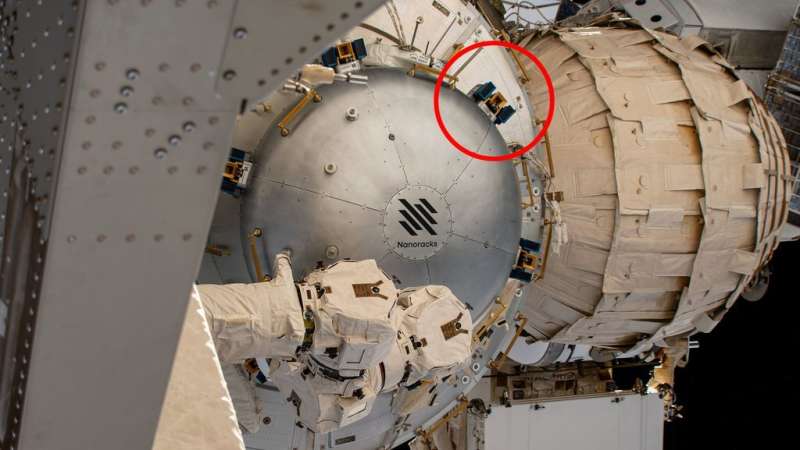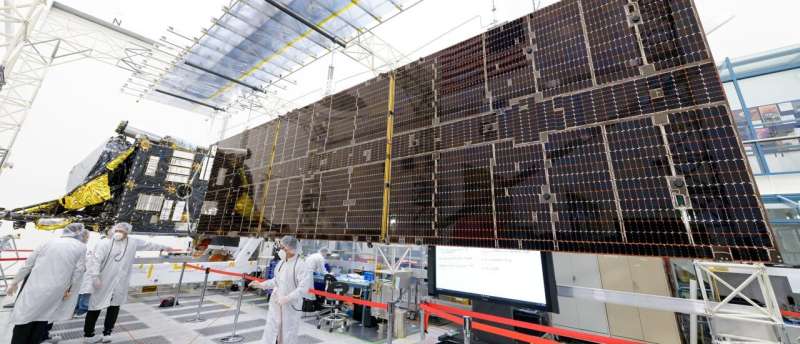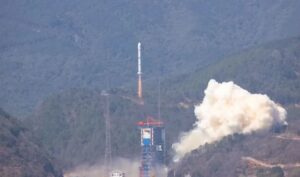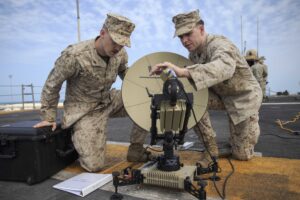China's space station to host 6 astronauts by end of 2022
Tuesday, 08 March 2022 04:50 China's space station is expected to host six astronauts from two spaceships by the end of 2022, according to the chief designer of the country's manned space program.
The Shenzhou-13 crew has been in orbit for 140 days. They are in good health, and have so far completed all planned or added tasks as needed. They are expected to return to Earth in mid-April, Zhou Jianping said.
This
China's space station is expected to host six astronauts from two spaceships by the end of 2022, according to the chief designer of the country's manned space program.
The Shenzhou-13 crew has been in orbit for 140 days. They are in good health, and have so far completed all planned or added tasks as needed. They are expected to return to Earth in mid-April, Zhou Jianping said.
This China launches seven new satellites
Tuesday, 08 March 2022 04:50 China has successfully sent seven satellites into space from the Xichang Satellite Launch Center in southwest China's Sichuan Province Saturday.
Six satellites produced by Beijing-based GalaxySpace and a commercial remote sensing satellite were launched by a Long March-2C carrier rocket at 2:01 p.m. (Beijing Time) and have entered their planned orbit.
The satellites will verify the n
China has successfully sent seven satellites into space from the Xichang Satellite Launch Center in southwest China's Sichuan Province Saturday.
Six satellites produced by Beijing-based GalaxySpace and a commercial remote sensing satellite were launched by a Long March-2C carrier rocket at 2:01 p.m. (Beijing Time) and have entered their planned orbit.
The satellites will verify the n Beames becomes SpiderOak’s chairman of the board
Tuesday, 08 March 2022 04:01
SmallSat Alliance Chairman Charles Beames is taking the helm of cybersecurity firm SpiderOak as chairman of the board.
The post Beames becomes SpiderOak’s chairman of the board appeared first on SpaceNews.
Space station to host 'self-healing' quantum communications tech demo
Monday, 07 March 2022 20:32
A tiny experiment launching to the International Space Station later this year could set the stage for a future global quantum network. Called the Space Entanglement and Annealing QUantum Experiment (or SEAQUE), the milk-carton-size technology demonstration will test two communications technologies in the harsh environment of space.
Quantum computers hold the promise of operating millions of times faster than conventional computers, and distributed quantum sensors may lead to new understandings of Earth and our place in the universe by measuring minute changes in gravity.
Intelsat picks David Wajsgras as next CEO
Monday, 07 March 2022 20:00
Intelsat has picked former Raytheon executive David Wajsgras as CEO to lead the satellite operator post-bankruptcy.
The post Intelsat picks David Wajsgras as next CEO appeared first on SpaceNews.
Op-ed | Russian threats a reminder of the need to protect GPS
Monday, 07 March 2022 20:00
The space-based navigation capabilities of the United States and its allies remain vulnerable to spoofing, denial and attack
The post Op-ed | Russian threats a reminder of the need to protect GPS appeared first on SpaceNews.
NASA's Psyche gets huge solar arrays for trip to metal-rich asteroid
Monday, 07 March 2022 17:14
With its solar arrays installed, the spacecraft is close to its final configuration ahead of a planned August launch.
NASA's Psyche mission is almost ready for its moment in the Sun—a 1.5-billion-mile (2.4-billion-kilometer) solar-powered journey to a mysterious, metal-rich asteroid of the same name. Twin solar arrays have been attached to the spacecraft body, unfolded lengthwise, and then restowed.
Hubble's Advanced Camera for Surveys celebrates 20 years of discovery
Monday, 07 March 2022 16:27
Today marks the 20th anniversary of the Advanced Camera for Surveys (ACS) aboard the NASA/ESA Hubble Space Telescope. On 7 March 2002 astronauts installed the ACS during Hubble Servicing Mission 3B, also known as STS-109. With its wide field of view, sharp image quality, and high sensitivity, the ACS delivers many of Hubble's most impressive images of deep space.
The ACS wavelength range extends from the ultraviolet, through the visible and out to the near-infrared. Its name, the Advanced Camera for Surveys, comes from its particular ability to map large areas of the sky in great detail. The ACS can also perform spectroscopy with a special optical tool called a grism.
Three subinstruments make up the ACS. The Wide Field Channel is a high-efficiency, wide-field, optical and near-infrared camera that is optimized to hunt for galaxies and galaxy clusters in the remote and ancient Universe, at a time when the cosmos was very young. The High Resolution Channel was designed to take extremely detailed (high resolution) pictures of the light from the centers of galaxies with massive black holes, though this is not currently operational, and the Solar Blind Channel blocks visible light to allow faint ultraviolet radiation to be discerned.
NASA rocket launches from Alaska in search of aurora answers
Monday, 07 March 2022 14:51
A NASA Black Brant IX sounding rocket soared high out of Poker Flat Research Range north of Fairbanks at 2:27 a.m. Saturday to learn more about pulsating aurora.
The Loss through Auroral Microburst Pulsations, or LAMP, experiment seeks to determine whether the pulsating aurora is connected to another phenomenon called microbursts, higher-energy electrons from the Earth's magnetosphere driven toward Earth in bursts that last about one-tenth of a second. That is faster than the pulsating aurora but similar to the flickering inside the pulsations.
A pulsating aurora looks patchy and occurs within minutes or sometimes hours after the conclusion of a discrete aurora, the familiar curtain-like type of aurora.
The launch had been repeatedly postponed since the Feb. 24 opening of the launch window because scientists needed the right combination of active aurora and good weather at a camera site in Venetie, which is located more than 130 miles north of the range.
Weather and aurora activity improved in recent days. Alexa Halford, space physics researcher at NASA's Goddard Space Flight Center and the experiment's lead investigator, detected pulsating aurora over Venetie early Saturday and determined that launch conditions were favorable.
Solar Orbiter crosses the Earth-Sun line as it heads for the Sun
Monday, 07 March 2022 12:00
The ESA/NASA Solar Orbiter spacecraft is speeding towards its historic first close pass of the Sun. On 14 March, the spacecraft will pass the orbit of Mercury, the scorched inner planet of our Solar System, and on 26 March it will reach closest approach to the Sun.
China launches test satellites for broadband constellation
Monday, 07 March 2022 11:04
China launched a set of commercial satellites Saturday for testing broadband services, on-orbit networking and integrating communications and remote sensing technologies.
DoD wants ‘resilient’ space systems, but how to get there is still unclear
Sunday, 06 March 2022 21:40
What it will take to make DoD constellations more resilient and achieve space superiority is still being debated, industry executives said.
The post DoD wants ‘resilient’ space systems, but how to get there is still unclear appeared first on SpaceNews.
Russia stops deliveries of rocket engines to US, Roscosmos Head Says
Sunday, 06 March 2022 08:36 Earlier in the week, Roscosmos head Dmitry Rogozin refuted claims that the Russian space agency had allegedly "lost control" of its satellites, stressing that any cyberattacks against the country's satellites are a "casus belli".
Russia will stop deliveries of rocket engines to the United States, Roscosmos head Dmitry Rogozin announced Thursday.
"Not only are we refusing to supply th
Earlier in the week, Roscosmos head Dmitry Rogozin refuted claims that the Russian space agency had allegedly "lost control" of its satellites, stressing that any cyberattacks against the country's satellites are a "casus belli".
Russia will stop deliveries of rocket engines to the United States, Roscosmos head Dmitry Rogozin announced Thursday.
"Not only are we refusing to supply th Tiangong scheduled for completion this year
Sunday, 06 March 2022 08:36 China's Tiangong space station is scheduled to be completed before the end of this year and will become a massive spacecraft stack with a combined weight of nearly 100 metric tons, according to a program leader.
Zhou Jianping, chief designer of the nation's manned space program, said the assembly phase of the Tiangong program will begin in May and will involve the launch of two astronaut c
China's Tiangong space station is scheduled to be completed before the end of this year and will become a massive spacecraft stack with a combined weight of nearly 100 metric tons, according to a program leader.
Zhou Jianping, chief designer of the nation's manned space program, said the assembly phase of the Tiangong program will begin in May and will involve the launch of two astronaut c Sino-European joint space mission conducts magnetometer extension test
Sunday, 06 March 2022 08:36 A China-Europe joint space mission, Solar Wind Magnetosphere Ionosphere Link Explorer (SMILE), has successfully carried out the extension test of its payload magnetometer in Europe, Science and Technology Daily reported Wednesday.
The test shows that the function and performance of the magnetometer subsystem integrated with the payload module meet the mission requirements and that the rese
A China-Europe joint space mission, Solar Wind Magnetosphere Ionosphere Link Explorer (SMILE), has successfully carried out the extension test of its payload magnetometer in Europe, Science and Technology Daily reported Wednesday.
The test shows that the function and performance of the magnetometer subsystem integrated with the payload module meet the mission requirements and that the rese 